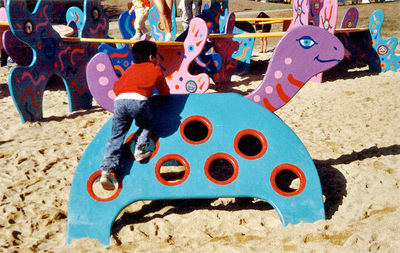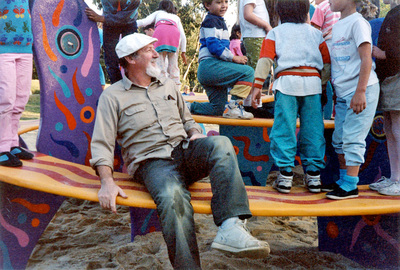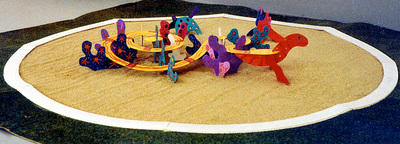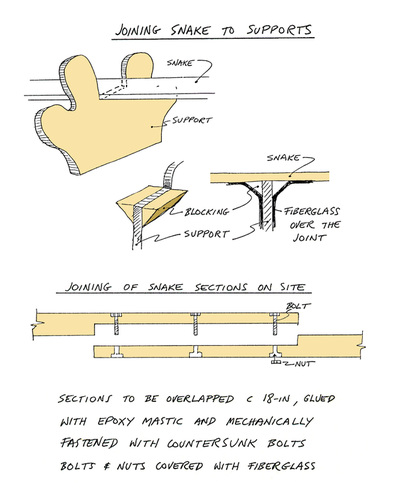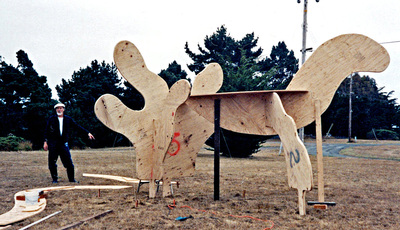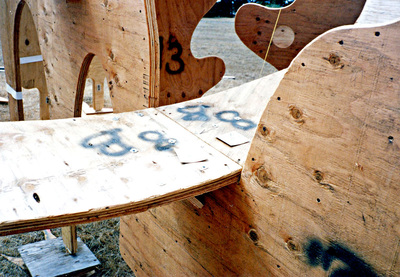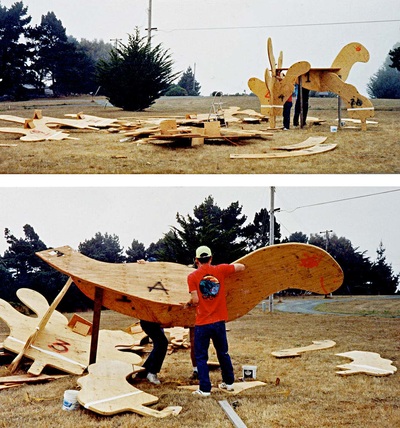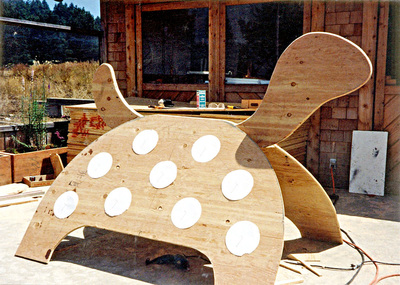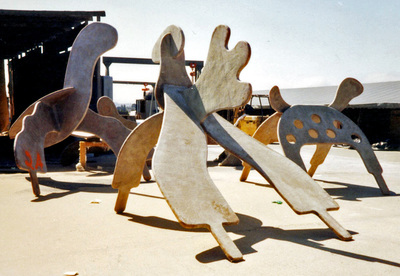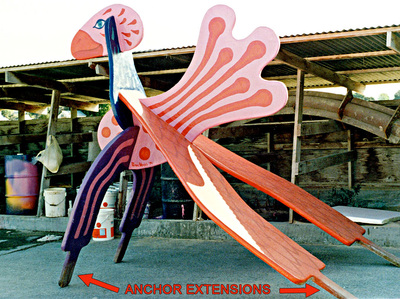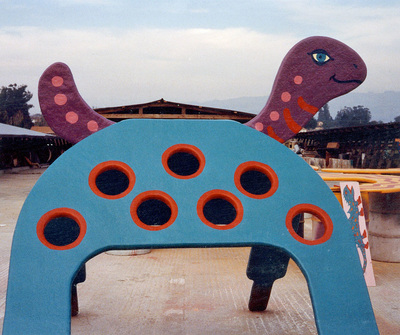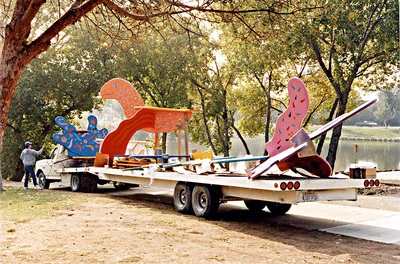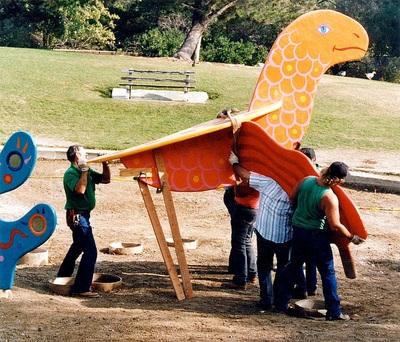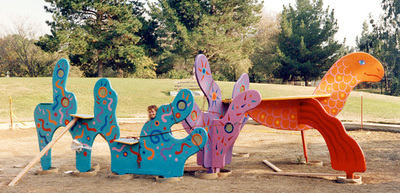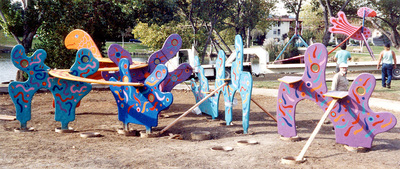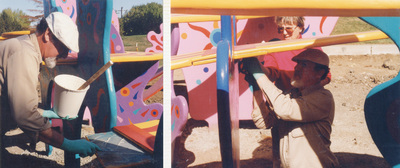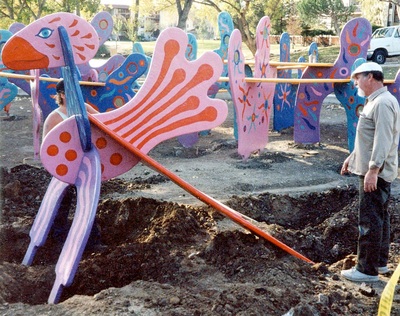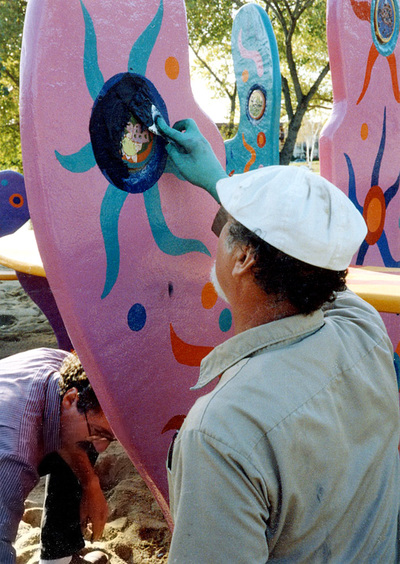FRIENDL & FRIENDS 1991
A non-mosaic work
Friendl & Friends
Ellis Lake Park, Concord, CA
One large and two smaller climbing and sliding sculptures, c. 1800 sq. ft. total.
Fiberglass-clad plywood structure, colored with plastic resin paints, with ceramic tiles made by local children.
Ellis Lake Park, Concord, CA
One large and two smaller climbing and sliding sculptures, c. 1800 sq. ft. total.
Fiberglass-clad plywood structure, colored with plastic resin paints, with ceramic tiles made by local children.
THE BACKGROUND
In the fall of 1990, the Art in Public Places Program of the City of Concord, CA, announced a competition for a project “to create a play sculpture, specifically designed for children 2-6 years of age, in Ellis Lake Park” in Concord.
In January 1991, after I had submitted the usual set of slides and resume and a proposal, I was told that both the Arts Committee and the Park and Recreation Commission “responded favorably” to my submissions at their November 1990 meeting. So I passed the first stage and was selected to go through the next set of hoops including a site visit, a couple of meetings with the Arts Committee and City Council, and a presentation of my final design plans by March 26.
In May my project was approved by all the proper authorities and I could begin the actual work on the project, though the contractual gymnastics dragged on into August. The installation date was set at November 15.
In the fall of 1990, the Art in Public Places Program of the City of Concord, CA, announced a competition for a project “to create a play sculpture, specifically designed for children 2-6 years of age, in Ellis Lake Park” in Concord.
In January 1991, after I had submitted the usual set of slides and resume and a proposal, I was told that both the Arts Committee and the Park and Recreation Commission “responded favorably” to my submissions at their November 1990 meeting. So I passed the first stage and was selected to go through the next set of hoops including a site visit, a couple of meetings with the Arts Committee and City Council, and a presentation of my final design plans by March 26.
In May my project was approved by all the proper authorities and I could begin the actual work on the project, though the contractual gymnastics dragged on into August. The installation date was set at November 15.
DESIGN
From the City’s Announcement of the Project:
"The piece must be durable and low maintenance. Materials should be able to withstand the elements which at times include extreme heat and humidity, cold, water and unfortunately, vandals. (This last word was prophetic!)
A unique feature of the scope of this project is the suggestion that school children from the Ellis Lake neighborhood create some of the tiles to be included in the sculpture. This would get the residents adjacent the park involved and give a sense of ownership to that community."
Having already built two playground serpents, I decided to go for a third, but with a very different design and in a different material. In fact, this really is not a mosaic piece at all, though there are some tiles in the story.
The piece, actually 3 pieces, were made of two-ply ¾-in. marine plywood, intersecting in ways to hold the structures together. All of the surfaces were flat.
The main piece was a long horizontal serpentine platform supported by a series of vertical forms, with shapes recalling the cutouts of Matisse’s late paper works.
I made models of the pieces in cardboard and colored their surfaces. The final colors were in plastic resin paint.
From the City’s Announcement of the Project:
"The piece must be durable and low maintenance. Materials should be able to withstand the elements which at times include extreme heat and humidity, cold, water and unfortunately, vandals. (This last word was prophetic!)
A unique feature of the scope of this project is the suggestion that school children from the Ellis Lake neighborhood create some of the tiles to be included in the sculpture. This would get the residents adjacent the park involved and give a sense of ownership to that community."
Having already built two playground serpents, I decided to go for a third, but with a very different design and in a different material. In fact, this really is not a mosaic piece at all, though there are some tiles in the story.
The piece, actually 3 pieces, were made of two-ply ¾-in. marine plywood, intersecting in ways to hold the structures together. All of the surfaces were flat.
The main piece was a long horizontal serpentine platform supported by a series of vertical forms, with shapes recalling the cutouts of Matisse’s late paper works.
I made models of the pieces in cardboard and colored their surfaces. The final colors were in plastic resin paint.
FABRICATION
From my Proposal:
"All parts of sculptures are of two layers of 3/4-in. CDX plywood, clad in two layers (c. 1/8-in.) of fiberglass reinforced plastic (FRP). Over the FRP is sprayed a pigmented gelcoat (a smooth, hard surface layer of polyester resin), with a UV retarder. The detail painting is also of colored gelcoat, painted over the first gelcoat layer.
About 20 tiles, to be provided by a local children's ceramic workshop, will be installed on the sculpture on the site. They will be inset in the surfaces of the Serpent's support sections, attached and grouted with silicon adhesive.
I will provide an exact full-scale grid for the location of the anchoring footings, which will be dug and prepared by the staff of the Concord Parks Department, who will be charged with the installation of this project."
Again, as with Animaze, there was the problem of mapping the placement of the great serpent structure with its many anchoring feet. And again I made a “map” of wooden lath, connecting all the anchor points with triangles.
PLYWOOD PIECES
I made the plywood forms in Mendocino and assembled them to test their stability. The two smaller pieces, the Bird and the Turtle, were assembled as permanent pieces. They both had anchoring “feet” as part of their plywood shapes that were intended as anchors to be set in concrete.
The serpent was made in sections that could be disassembled for transport and reassembled at the site. The large forward part, a creature with intersecting head and feet, as well as the series of supporting uprights, were to be shipped as sections and assembled at the site. All the upright pieces had anchor feet as part of their shapes.
In many places in the upright supports for the snake platform, I left spaces for round c.6-in. ceramic tiles. I had contacted a teacher in a ceramics program in the Ellis Lake area, and she agreed to have her child potters make decorated glazed ceramic discs for the park sculpture. I suggested the kids use 6” paper plates for developing the designs they would then transfer to the ceramic disks. I think they delivered some two dozen tiles.
From my Proposal:
"All parts of sculptures are of two layers of 3/4-in. CDX plywood, clad in two layers (c. 1/8-in.) of fiberglass reinforced plastic (FRP). Over the FRP is sprayed a pigmented gelcoat (a smooth, hard surface layer of polyester resin), with a UV retarder. The detail painting is also of colored gelcoat, painted over the first gelcoat layer.
About 20 tiles, to be provided by a local children's ceramic workshop, will be installed on the sculpture on the site. They will be inset in the surfaces of the Serpent's support sections, attached and grouted with silicon adhesive.
I will provide an exact full-scale grid for the location of the anchoring footings, which will be dug and prepared by the staff of the Concord Parks Department, who will be charged with the installation of this project."
Again, as with Animaze, there was the problem of mapping the placement of the great serpent structure with its many anchoring feet. And again I made a “map” of wooden lath, connecting all the anchor points with triangles.
PLYWOOD PIECES
I made the plywood forms in Mendocino and assembled them to test their stability. The two smaller pieces, the Bird and the Turtle, were assembled as permanent pieces. They both had anchoring “feet” as part of their plywood shapes that were intended as anchors to be set in concrete.
The serpent was made in sections that could be disassembled for transport and reassembled at the site. The large forward part, a creature with intersecting head and feet, as well as the series of supporting uprights, were to be shipped as sections and assembled at the site. All the upright pieces had anchor feet as part of their shapes.
In many places in the upright supports for the snake platform, I left spaces for round c.6-in. ceramic tiles. I had contacted a teacher in a ceramics program in the Ellis Lake area, and she agreed to have her child potters make decorated glazed ceramic discs for the park sculpture. I suggested the kids use 6” paper plates for developing the designs they would then transfer to the ceramic disks. I think they delivered some two dozen tiles.
FIBERGLASS AND PAINT
When finished, the plywood pieces were shipped to Bill Kreysler’s shop in Penngrove (as the pieces of Animaze had been). There they were clad in layers of fiberglass and then spray painted with colored gelcoat. Over these gelcoat surfaces, I hand painted all the decorative elements in pigmented gelcoat .
When finished, the plywood pieces were shipped to Bill Kreysler’s shop in Penngrove (as the pieces of Animaze had been). There they were clad in layers of fiberglass and then spray painted with colored gelcoat. Over these gelcoat surfaces, I hand painted all the decorative elements in pigmented gelcoat .
INSTALLATION
On November 12 the finished pieces were trucked to the site at Ellis Lake Park. The Bird and Turtle sculptures were pre-assembled and ready for installation. The Serpent traveled in several sections and had to be re-assembled. It took four days to complete the installation.
First I assembled the lath “map” for the Serpent and we sited the anchor holes for all the many anchor feet of the support sections. Then the holes were dug, the Sonotubes set, and the support sections placed in their proper positions.
On November 12 the finished pieces were trucked to the site at Ellis Lake Park. The Bird and Turtle sculptures were pre-assembled and ready for installation. The Serpent traveled in several sections and had to be re-assembled. It took four days to complete the installation.
First I assembled the lath “map” for the Serpent and we sited the anchor holes for all the many anchor feet of the support sections. Then the holes were dug, the Sonotubes set, and the support sections placed in their proper positions.
On the second day, as more of the support sections were put into position, the raised platform of the Serpent's body was set in place and the anchors were backfilled with concrete. The Bird and Turtle were unloaded and positioned, but not yet secured in place.
On the third day, the sections of the Serpent's body were fastened with epoxy and bolts and the Bird and Turtle were anchored in concrete.
On the fourth day, November 15, the day of the dedication, there was still much to do. Several truckloads of sand were dumped and spread over the whole play area, in and around the sculptures. The decorated ceramic tiles made by local children were brought to the site and were set in the spaces reserved for them on the horizontal surfaces of the Serpent's support sections. We were doing the final cleaning of the grout even as the crowd was gathering for the dedication.
CODA
The fate of this play sculpture is unknown to me. Thirteen and a half years after I left it to fend for itself, I find no sign of it on Google’s views of Ellis Lake Park. I see a couple of standard metal climbing structures in the large and mostly empty circle where my pieces’ stood colorful shapes once stood. Perhaps the vandals we were warned about had their way. Perhaps the city just wanted a more conventional play structure. At any rate, these photos are what is left to show of this work.
The fate of this play sculpture is unknown to me. Thirteen and a half years after I left it to fend for itself, I find no sign of it on Google’s views of Ellis Lake Park. I see a couple of standard metal climbing structures in the large and mostly empty circle where my pieces’ stood colorful shapes once stood. Perhaps the vandals we were warned about had their way. Perhaps the city just wanted a more conventional play structure. At any rate, these photos are what is left to show of this work.





